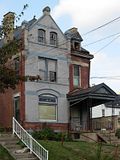The brick-and-stucco home at 1626 W. Boston Blvd. has watched almost a century of Detroit's ups and downs, through industrial brilliance and racial discord, economic decline and financial collapse. Its owners have played a part in it all. There was the engineer whose innovation elevated auto makers into kings; the teacher who watched fellow whites flee to the suburbs; the black plumber who broke the color barrier; the cop driven out by crime.
The last individual owner was a subprime borrower, who lost the house when investors foreclosed.
...But, battered and forlorn today, both Detroit and 1626 W. Boston Blvd. were solid and optimistic 90 years ago.
Taking a new route on vacation this spring, I passed through urban St. Louis for the first time. The gorgeous houses near the freeway took my breath away, but all too evident were the signs of urban decay. Who had built those homes, and what would they make of them now? The downward trend isn't unique to St. Louis or Detroit. I see this decline duplicated in areas of Cincinnati: neighborhoods that used to be proud and gracious have become battered and sullen.
Via the Building Cincinnati Photobucket site, which has numerous albums of Cincinnati photos.
Perhaps it's because until I was 12, my family lived in a succession of rather disposable trailers, but it tears me apart to see a fine old house in a state of neglect or active disrepair. True, for a good formative period, one of those trailers was on nine acres of land in rural Virginia, so the outdoor splendor more than compensated for disposable living quarters. Still, I remember when we were planning to move to Ohio, my siblings and I carefully wrote out a list of what we wanted in a house: wood floors, a fireplace, a secret passageway, a laundry chute -- marks of a home that was built quality, built to last. (As it turned out, we had all four in the house we first rented. There was a pathway in the attic that ran between the two upstairs bedrooms, and if you wanted to sit peacefully up there, you nestled against the brick chimney that jutted into the space. The fireplace had been turned into the kitchen pantry, but no matter; we knew it had once been there. We put the cat down the laundry chute, and there is no consensus of memory on whether we tried the same with the baby.)
It did not occur to me as a child that some people would not value a beautiful older house in a beautiful older neighborhood. Perhaps the term "Victorian" applied to architecture had a particular allure because it was so different from where I lived. The concept of upkeep or the desire to flee a crime-ridden neighborhood despite the original glory of the houses were completely alien ideas, as were "white flight", "urban decay", or "factory closing". But I did know that in 100 years our trailer would be rubble (as indeed will the suburban box I now inhabit), whereas even at their century, the gorgeous homes that were built for living and built to last still cast spells even through a heavy haze of neglect.
On a related note, my dad's nearly 100-year-old house is still for sale. Go ye forth and buy it.This past April, the Central Detroit Christian Community Development Corp., a nonprofit, bought Clarence Avery's house for $10,000.
One day this summer, Lisa Johanon, the group's executive director, undid the padlock on John Crawford's boarded-up front door. Sheets of peeling paint hung from Marie Ryan's kitchen ceiling. Advertising fliers littered the porch where Veronica Adams's neighbors played jacks. The glass was missing from the window on the staircase to David Andrews's third-floor sanctuary. Kimberly Carpenter's radiators had been stolen.
Usually, Ms. Johanon's charity provides subsidized housing in the poorest neighborhoods -- where ice-cream cones are sold from behind bullet-proof glass -- not high-end areas such as Boston-Edison. But now some 100 out of the 900-odd houses in Boston-Edison are vacant.
If you can't save 1626 W. Boston Blvd., Ms. Johanon wondered aloud, what hope is there for the rest of Detroit? Walking through, she noted the heavily stained carpet and the rickety back steps, but also the rich woodwork and the clawfoot tub.
She hopes her group can revive the house and find a new family willing to bet on Detroit. "A minimal spec, I'd say, would be $30,000 to $35,000, and it would be in pretty good shape," she said.







1 comment:
Good luck to your dad. With sorrow and relief, we sold our 90 yr old house in Va this summer. It was in a neighborhood that, about 20 yrs ago, was revivified by the alternative lifestyle community. These crumbling old homes were given a second life as apartments and rentals, and trendy restaurants, an arts and classics movie theater, and cutesy gift shops moved in. Without some people willing to live on the edge, those places in Detroit and Cincinnati, and elsewhere, may just disintegrate.
Post a Comment